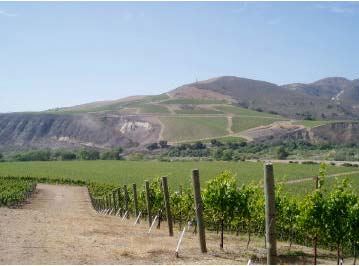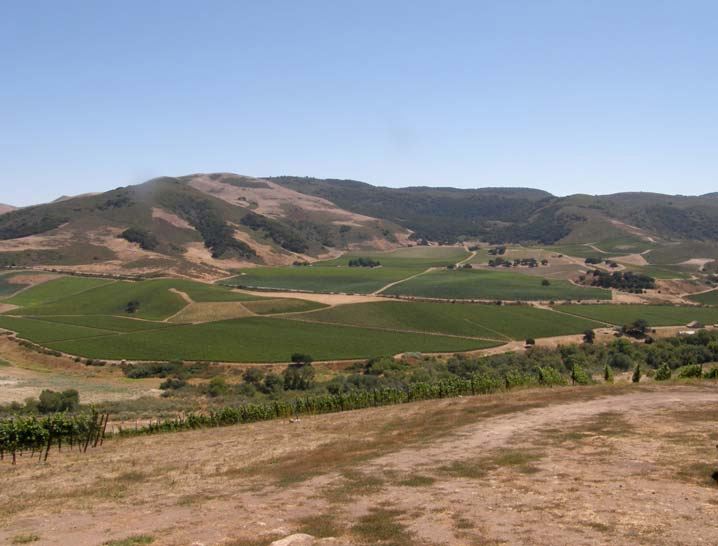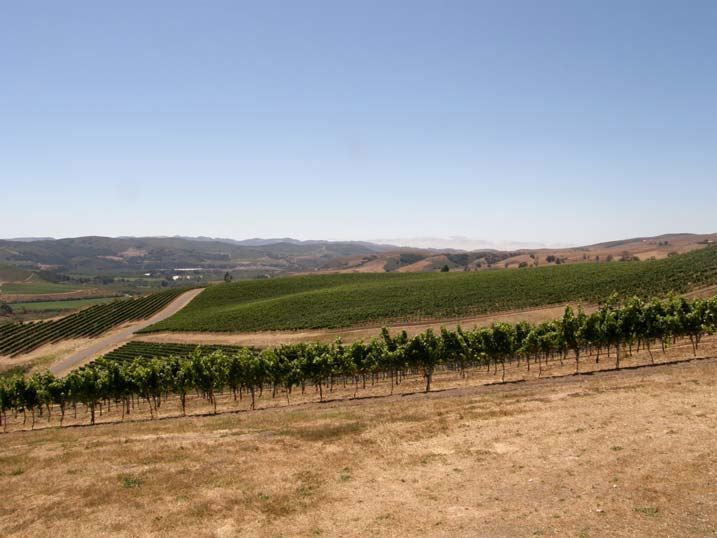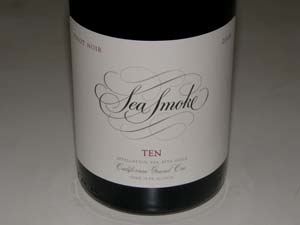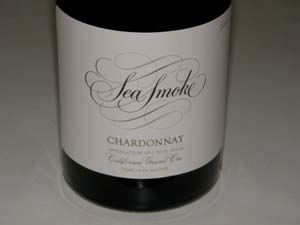Sea Smoke Cellars: California Cult Classic
Sea Smoke is one of a handful of California Pinot Noir producers whose fruit-powered style has quickly
captured the attention of pinotphiles. Bob Davids, a Burgundy aficionado and CEO of a highly successful
computer game company, acquired 350 acres of farmland overlooking the Santa Ynez River in 1999 and
began development of the 105-acre Sea Smoke Vineyard the same year. He chose south-facing hillside bluffs
situated above Fiddlestix Vineyard in the Sta. Rita Hills appellation of Santa Barbara County. From the
beginning, the emphasis has been on meticulous vineyard management led by a highly skilled vineyard team.
Ten Pinot Noir clones are planted in 26 unique geographic blocks of the large vineyard which has six soil types
and elevations ranging from 300 to 700 feet above sea level. The first photo below of Sea Smoke Vineyard is
taken from Fiddlestix Vineyard looking toward the north with Sea Smoke vines on the hillsides in the distance.
The second photo shows the Sea Smoke Vineyard from its highest point with Fiddlestix Vineyard in the
foreground, then Santa Rosa Road, Sanford & Benedict Vineyard, La Encantada Vineyard, and the Santa
Rosa east-west mountain chain visible in the distance. The third photo shows one aspect of the Sea Smoke
Vineyard.
The Pinot Noir clones planted include Dijon 113, 115, 459, 667, 777, 09, 16, Pommard 5, 2A, and Mt. Eden
Selection. The Chardonnay clones are Wente and Dijon 76, 95 and 96.
Individual blocks and clonal combinations are vinified separately and provide a complex palate for blending
decisions intended to reflect the terroir of the site. The initial winemaker was Kris Curren, who left in 2007 to
join Foley Estates, replaced by Don Schroeder who was Curran’s assistant and a winemaker at Ampelos
Cellars. Victor Gallegos, educated at University of California Davis, is the director of winemaking and
viticulturist. Schroeder has proven to be a fortunate hire, for working together with Gallegos, the pair have
taken the wines in a subtle, but more appealing direction in my opinion, with less alcohol, slightly less
extraction, and reduced new oak elevage. According to the winery spokespeople, “The 2009 vintage marked
the culmination of a subtle stylistic shift at Sea Smoke - a measured fine tuning to further enhance the aging
ability of Sea Smoke’s wines, through slightly lower alcohol levels and the finessing of new oak ratios during
barreling.” They have not changed their picking regime, which is still aimed at tannin and flavor ripeness but
have altered their winemaking regimen without resorting to de-alcoholizing the wines.
The first Sea Smoke Pinot Noir was released from the 2001 vintage and instantly acquired an enthusiastic
following. A new winery was built in Lompoc and the 2009 vintage, reviewed here, was the first to be vinified
there. The large space available in the new winery and almost 40 fermenters allows for focused work with the
50 distinct small individual fermentation lots.
Yields were the highest ever from the Sea Smoke Vineyard in 2009 at 2.3 tons per acre, but the cluster counts
per vine remained the same; quite low but with each cluster’s weight greater. More mailing list members were
offered wine in 2009, but unfortunately, yields dropped back to normal in 2010.
Beginning in 2002, there have been three Pinot Noirs produced at Sea Smoke: Botella which is fruit forward
with mild tannins; Southing, which is darker and more reticent initially; and Ten, which is made from a barrel of
each of the ten clonal selections grown on the estate vineyard. The Ten bottling has been crafted to be more
robust, vinified with a larger percentage of new oak that is from coopers with a more aggressive style, resulting
in more long-term age ability potential.
A Chardonnay is produced from three acres planted in the estate vineyard. The wine was initially intended for
charitable purposes and as a reward for mailing list members, thus the name “Gratis” for the wine. Many
customers requested that the Chardonnay be made available for purchase. An additional five acres of Wente
clone Chardonnay was planted in 2005 and beginning that year, a “Sea Smoke Chardonnay” was crafted along
with “Gratis.” Gratis is crafted with power and richness, while the Sea Smoke Chardonnay is more elegant and
refined because of a different cooperage program and the use of 25 percent stainless steel during
fermentation.
After sorting the grapes, the must undergoes a 1 to 4 day cold soak and is then inoculated with cultured yeasts.
The slow fermentation and maceration takes fourteen to eighteen days for the Southing and sixteen to twentyeight
days for the Ten. After settling, both free-run and press wines are racked to barrels and aged 16 months
in 55% new (Southing) and 65% new (Ten) French oak barrels. For the Sea Smoke Chardonnay, cold grapes
are softly pressed, cold settled and racked to both French oak barrels and a stainless steel fermenter. The
must is inoculated for primary fermentation and barrels are periodically stirred. The wine is aged 16 months in
55% new French oak barrels before bottling.
Sea Smoke wines are sold almost exclusively through distributors and a mailing “List” and highly allocated.
Visit the website at www.seasmoke.com to join the list. For questions about the list contact
customerservice@seasmokecellars.com. No tasting room is available at Sea Smoke because all the wine is
pre-allocated to List members. Occasionally wine is available at the Taste of Santa Rita Hills tasting room in
the Lompoc wine ghetto (www.tasteofstritahills.com). The winery is not open to the public for tours and
vineyard visits are not possible due to legal restrictions on public access.
2009 Sea Smoke Southing Sta. Rita Hills Pinot Noir
14.5% alc., pH 3.33, VA 0.67, $52.
·
Moderately deep
reddish-purple hue in the glass. Very reserved nose offering demure aromas of black fruits, oak char and spice
and violets. The black plum, cassis and black cherry fruit has impressive presence on the mid palate,
underscored with appealing earthy, iron and mineral character. The tannins are fine-grain and accommodating
and there is a good cut of acidity in the background. This seductive wine ends with an aromatic whiff of musk
and flowers. Shows an elegance missing from previous Sea Smoke vintages. Very good.
2009 Sea Smoke Sta. Rita Hills Chardonnay
14.9% alc., pH 3.42, TA 0.63,
$52.
·
Light straw yellow color in the glass. The nose offers reserved aromas of
honeycomb, lemon pastry, sandalwood and a hint of mocha. Well-endowed with
flavors of lemon curd, baked apple, roasted nuts and toasty oak. Creamy on the
palate with integrated acidity and a dry, citrus-driven finish. Very good.

2009 Sea Smoke Ten Sta. Rita Hills Pinot Noir
14.5% alc., pH 3.39,
TA 0.67, $80.
·
Moderately deep reddish-purple color in the glass. Fresh
and vibrant perfume of purple berry compote, plum reduction sauce and
hibiscus tea, offering displaying more intensity over time in the glass. This
wine offers flavors of blackberries, Hoison sauce in perfect balance with
refined tannins and vital acidity. The purity of the fruit really grabs your
attention as it unfolds in layers across the palate. The mouth feel is velvety, the
oak is beautifully integrated, and there is very impressive length on the fruit-laden
finish and a step up in pleasure from the Southing bottling. Honed to go the
distance in the cellar.
2002 Sea Smoke Southing St. Rita Hills Pinot Noir
14.1% alc..
·
Dark reddish-purple color in the glass.
Bright aromas of darker berry compote with notes of graham and leaf. Richly endowed with appealing dark
berry fruit, showing an earthy and smoky tone, and lashed with oak and firm tannins. Still holding and should
last several more years but will always be a tannic wine. Good (+).
2001 Sea Smoke Botella Sta. Rita Hills Pinot Noir
14.1% alc.. Inaugural vintage.
·
Moderately dark reddish-purple
with slight bricking of the rim. Brooding aromas of prunes, oak, herbs and cardamom spice. Moderately
rich and ponderous with a core of very ripe, roasted dark fruits including black raspberries and black plums.
Noticeable oak tannins with hi-tone acidity on the finish. Meant for earlier drinking and has run its course. Drink up. Decent.
Grand Cru Vineyards in California?
Sea Smoke caused a bit of a stir when they released their 2009 wines with the phrase, “California Grand
Cru,” on the front label. Naysayers pointed out that the Sea Smoke vineyard is only a little over ten years
old, with not enough vintages to justify such a claim of distinction.
Currently, California does not have a formal classification of vineyard quality such as Burgundy's cru
system based on well-defined climats. This is understandable, as most California Pinot Noir vineyards are
relatively young. As Remington Norman points out in his new book, Grand Cru, “The working idea of
Grand Cru is both thoroughly Burgundian and thoroughly pragmatic. It reflects the fact that over the
centuries the quality of wines from certain plots has consistently out performed that of their neighbors,
irrespective of the grape variety planted on them.” The important word here is “centuries.” In Burgundy,
even with that much experience with specific vineyards, there remains controversy over the classification
with some Grands Crus (or at least part of the vineyard) undeserving of that designation and some Premier
Crus deserving of the title, but not so designated.
Not to brag, but to make a point, I have tasted Pinot Noir from every notable Pinot Noir vineyard in
California. Considering my experience and the quality of the wines tasted (aromatic interest, complexity,
persistence after swallowing, and capacity to age with interest), the following vineyards come to mind
when I think of California vineyards of potentially Grand Cru quality: Calera Jensen, Hanzell, Mount Eden,
Donum Estate, Rochioli, Summa, Hirsch, Savoy, Pisoni, Bien Nacido, and Fiddlestix. Beyond these
choices, there are literally hundreds of vineyards for which arguments could be made for inclusion in this
select club.
It is a fertile (sic) topic to debate, but do not look for a vineyard classification system to be forthcoming
soon in California. The biggest challenge to arriving at such a classification would be determining who
would decide?



